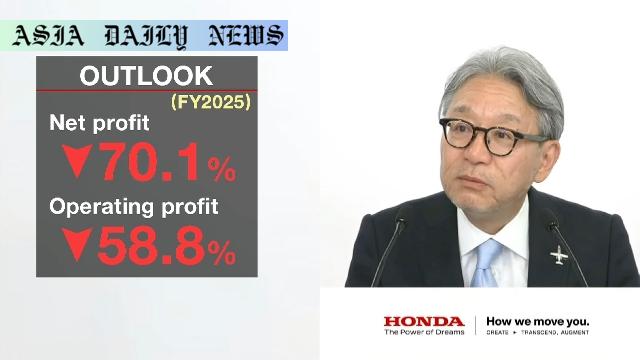Honda profits forecast 70.1% drop due to US tariffs, currency impact.
Key Point 1: Honda forecasts a massive 70.1% fall in net profit for FY2025.
Key Point 2: US tariffs and foreign exchange challenges will heavily impact revenues.
Key Point 3: Operating profit also expected to decline by 58.8% this year.
Key Point 4: Overall sales likely to see more than 6% drop, amounting to 20.3 trillion yen.

Decline in Honda’s Profit Forecast: A Financial Overview
Honda Motor Co., one of the world’s leading automobile manufacturers, has predicted a substantial decline in its profit for the fiscal year ending March 2025. The financial forecast reveals that the company is bracing for a 70.1% drop in group net income, which will result in earnings of approximately 250 billion yen (or 1.7 billion dollars). This decline is attributed to escalating US tariff policies and turbulent foreign exchange fluctuations. Honda, headquartered in Tokyo, announced this outcome on Tuesday, presenting a challenging fiscal outlook amidst global economic uncertainties.
The automaker anticipates its operating profits to decrease by 58.8%, signifying a significant blow to its financial health. The projected decline in sales revenue, estimated to fall more than 6% to 20.3 trillion yen (approximately 130 billion USD), further intensifies the gravity of the fiscal downturn. These projections underscore the complicated macroeconomic pressures, particularly the effect of US tariffs, estimated to result in a profit reduction of 450 billion yen (or about 3 billion dollars). Combined with the losses incurred by the foreign currency exchange headwinds, the total impact could cost the company close to 6 billion dollars.
The Impact of US Tariffs and Currency Fluctuations
US-imposed tariffs have played a significant role in the anticipated financial strain on Honda’s profitability. By increasing the operational costs of conducting business in the United States, tariffs have considerably reduced the company’s earnings potential in its largest overseas market. Despite Honda’s diversified global presence, the escalating trade tensions have hampered its ability to stabilize production costs or offset losses. Consequently, the company faces tougher competition, limited maneuverability, and higher prices for both production parts and exported vehicles.
Additionally, currency fluctuations have further complicated the automaker’s economic strategy. With the yen’s value fluctuating amidst unpredictable geopolitical and financial variables, Honda’s revenues from international sources have experienced devaluation. Foreign exchange challenges often create layers of uncertainty, breeding potential operational inefficiencies in both short-term and long-term forecasts. Together, these external economic pressures are forcing Honda to reevaluate its strategies and long-standing practices.
Global Challenges and Strategic Adjustments
The forecasted sharp downturn in Honda’s profits raises critical concerns over global trade dynamics, technological exposure, and possible underperformance in key markets. Modern automotive manufacturers like Honda must cope with overlapping burdens: global competition, advancing technologies, and emerging policy shifts in sustainability. For Honda, these challenges become more pertinent given the growing shift towards electric vehicles (EVs), as the marketplace demands adaptation. Facing additional operational instability, Honda may need to redirect its focus on market adaptation, production optimization, and innovation priorities.
Looking forward, Honda’s leadership is likely to assess cost-saving tactics on non-essential investments, strategize production reports that promote low-volume sales models, and extend alliances with local US exporters. However, retaining its competitive edge amidst rising losses might require open investment and understanding of shifting consumer preferences impacted by globalization and digital disruptions.
Conclusion: Embracing Change for Financial Recovery
Honda Motor Co.’s alarming fiscal trajectory underscores the fragile relationship between global trade policies and corporate stability. The Japanese automaker’s 70% decline in earnings is a stark reflection of escalating economic complexities and marketplace pressures. By strategically maneuvering new supply chains, expanding EV market niches, and forming partnerships, the company could potentially reverse its downward trajectory. However, consistent innovation remains key to overcoming these adversities–positioning Honda toward future growth cycles. Operative, deliberate redesigning adaptability internal designs hierarchy supports solutions funnel externally limiting-featuring.



Commentary
Understanding Honda’s Financial Struggles
The recent data about Honda’s anticipated 70% decline in profits for FY2025 is a clear wake-up call that external factors like government policies and currency fluctuations can severely impact even the biggest global automakers. What’s particularly alarming is the sheer scale of the decline—billions of dollars lost to tariffs and foreign exchange woes. This development puts into perspective how interconnected the global trade system is and how no company, regardless of its size or reputation, is fully immune to policy changes and economic swings.
The US tariffs appear to be a significant stumbling block for Honda. With these levies increasing the costs of production and reducing the competitiveness of exported goods, Honda must grapple with tough decisions. Should it continue absorbing these costs, pass them on to consumers, or explore alternative supply chains and production facilities? None of these options are easy or cost-free, but the need for a well-thought-out approach is immediate and pressing.
Strategizing for Future Resilience
What Honda needs now more than ever is a strategic roadmap for long-term resilience. The automotive industry is already in a state of transformation, driven by electrification and sustainability goals. Honda is no exception and must look at ways to integrate these trends into its response to the current challenges. Collaboration with other automakers, investment in innovative technologies, and entering untapped markets, especially in the EV space, could help mitigate some of the ongoing losses and create new opportunities for revenue.
Ultimately, Honda’s struggles underscore the broader lesson for global businesses: adaptability and innovation are no longer optional. By proactively addressing these issues, Honda can position itself as not just a survivor of this financial storm but as a stronger player in the changing automotive landscape.